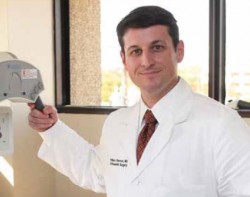Facing Forward
Dr. William Sherman takes a new approach to hip replacement.
 Growing up in Amite, La., Dr. William F. Sherman, Jr. always knew he wanted to be a physician. When he got to medical school at Louisiana State University, he found a perfect fit in the specialty of orthopaedics for its instant impact on patient quality of life.
Growing up in Amite, La., Dr. William F. Sherman, Jr. always knew he wanted to be a physician. When he got to medical school at Louisiana State University, he found a perfect fit in the specialty of orthopaedics for its instant impact on patient quality of life.
“You see an immediate result,” Dr. Sherman says. “People go from not being able to walk to being able to walk in a matter of hours. It’s something that drew me from the very beginning.”
After finishing his residency at LSU, Dr. Sherman completed a fellowship in adult joint reconstruction, or arthroplasty, at Harvard University Medical Center. He has a full-time academic appointment at the LSU Health Sciences Center Department of Orthopaedic Surgery, and serves as the department’s chief of arthroplasty, helping train future surgeons.
He focuses mainly on hip and knee replacement, including fixing prior replacements that have degraded or broken. “It’s one of the more mechanical fields of orthopaedics,” he says. “These are not small surgeries. They make huge differences.”
Joint replacement can solve or improve a variety of debilitating conditions, including arthritis and joint wear-and-tear. While the construction and durability of hip and knee implants have both changed somewhat since Dr. Sherman entered orthopaedics, he’s seen major advances in surgical methods. “The implants have improved over time; however, the real differences I’ve seen are the techniques we use to put them in,” he says. “We’re using X-rays, different computer technologies and robotic technologies.”
One recent development in orthopaedics is the use of an anterior, or front-facing, approach in hip joint replacement. “In the last four to five years, that has really caught on,” Dr. Sherman says. “The recovery is a little faster, and the precautions that the patients have to adhere to are much less strict, post-operatively.”
Depending on the complexity of their surgery, most hip replacement patients recover within three to six weeks. “For the knee, we tell patients somewhere between six to 10 weeks,” Dr. Sherman says. Patients usually begin physical therapy immediately, placing weight on the replaced joints with the aid of a walker, cane or crutches.
Dr. Sherman works with hospitals throughout New Orleans. He recently began seeing patients at Omega Hospital, and cites the hospital’s beautiful facility, and his talented colleagues, as two reasons he enjoys working there. “I’m just starting to work with them now,” he says. “That place is absolutely amazing.”
He loves sports and the outdoors, and often takes trips to hunt and fish. “I’m definitely an outdoorsman,” he says. As chief orthopaedic surgeon to the New Orleans Zephyrs baseball team, he can indulge two passions — sports and medicine — at once.
He also enjoys woodworking, a hobby of his since childhood, and draws parallels between this craft and his surgical work — though he sees woodworking as “a little more dangerous.”
DOCTOR INFO
William F. Sherman, Jr., M.D.
Omega Hospital Dept. of Orthopaedic Surgery
2525 Severn Ave.
Metairie, LA 70002
(504) 832-4200
MEDICAL SCHOOL: Louisiana State University School of Medicine
RESIDENCY: Louisiana State University School of Medicine, Orthopaedics
FELLOWSHIP: Harvard University Medical School, Adult Reconstruction/Arthroplasty
BOARD CERTIFICATIONS: Orthopaedic Surgery
